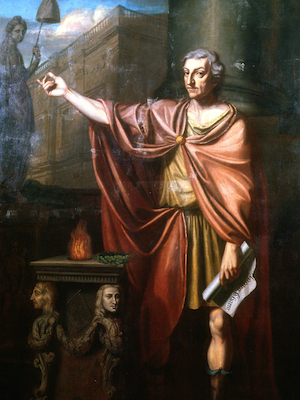 In 1769, a painting of William Pitt, Lord Chatham arrived at Chantilly, Westmoreland County, Virginia by ship from London. It was directed to “The Gentlemen of Westmoreland” by Edmund Jenings, Richard Henry Lee’s London Agent. The “Gentlemen” under the leadership of Lee were the 115 signers of the Leedstown Resolution.
In 1769, a painting of William Pitt, Lord Chatham arrived at Chantilly, Westmoreland County, Virginia by ship from London. It was directed to “The Gentlemen of Westmoreland” by Edmund Jenings, Richard Henry Lee’s London Agent. The “Gentlemen” under the leadership of Lee were the 115 signers of the Leedstown Resolution.
In the British Parliament there were staunch supporters of the colonies who fought for repeal of the stamp act and who sympathized with the colonies’ efforts to grow and prosper. Foremost among these friends were Charles Pratt, Lord Camden, and William Pitt, Lord Chatham, both of whom were considered for the painting.
Many of the “Westmoreland Gentlemen” had attended preparatory schools and universities in England, acquiring tastes of the nobility through their classmates. Many returned to Virginia aspiring to this aristocratic lifestyle and resolving not to bow to British demands to taxation without representation.
“The Gentlemen” wanted a masterpiece art symbol to show gratitude for the tax act repeal.
Charles Wilson Peale, a young inexperienced artist, newly arrived in London and struggling to make ends meet, agreed to take this commission.
When completed, the portrait became quite controversial as to why Mr. Pitt was pictured in Roman Consuls’ toga and the meaning of the various symbols throughout the portrait.
In the years preceding the revolution, Mr. Pitt was known in the colonies as a defender of the colonies. His picture was displayed in many homes. Towns such as Pittsfield, Massachusetts and Pittsburg, Pennsylvania were named in his honor. He brought honesty and integrity to the government and the British army. He was considered a political genius.
His son, William, at age 24 became the youngest prime minister in British history and had a distinguished career of his own.
The Pitt portrait resided at Chantilly 1769-1794, at Stratford 1794-1821, Old Court House 1821-1847, in the State Capital 1847-1902, New Court House 1902-1941, and in the present museum from 1941 to the present.

